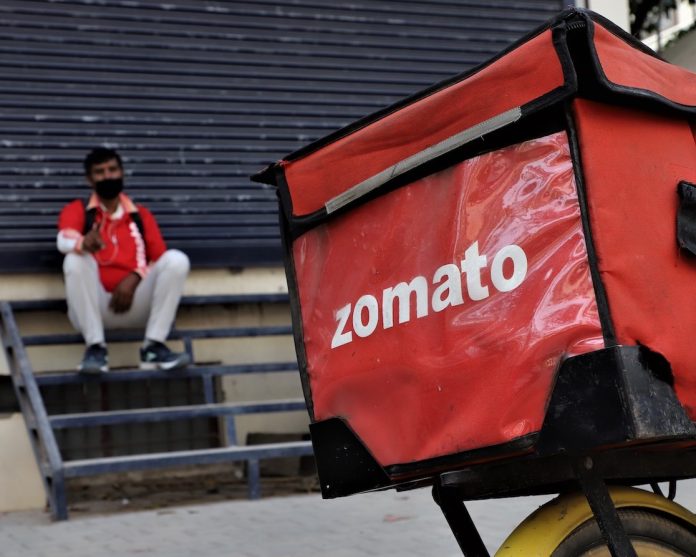This article has been written by Nikita Rathod. It has been edited by Ojuswi (Associate, LawSikho).
It has been published by Rachit Garg.
Table of Contents
Introduction
Zomato is an Indian restaurant aggregator and a food-delivery public limited company founded by Deepinder Goyal and Pankaj Chaddah in 2008. Over the years, the Company expanded its operation in India and throughout 23 countries. Since 2010, Zomato has raised an aggregate total of $2.5B through equity funding. The Company, despite being a startup, has acquired 14 companies since 2008. The most recent acquisition by Zomato is UberEats on 21st January 2020 in an all-stock acquisition followed by the acquisition of an instant grocery startup Blinkit for a value amount of Rs. 4,447 crores ($569 million) in an all-stock deal.
Blinkit, formerly known as Grofers, was established in December 2013 by Albinder Dhindsa and Saurabh Kumar in Delhi as an instant grocery delivery service platform. Over the years, the company expanded its operations throughout the major cities of India. Blinkit has raised an aggregate total of $1B through equity funding. Blinkit acquired two companies viz. Mygreenbox and Townrush on 10th April 2015 and 27th October 2015 respectively. In August 2021, Blinkit proposed its Unicorn status by raising $120 million from Zomato and Tiger Global. On 24th June 2022, the Board of Directors of Zomato Limited approved the acquisition of Blinkit for the value amount of Rs. 4,447 crores. The transaction was completed towards the end of August 2022.
Zomato’s motive behind the acquisition of Blinkit
The quick commerce industry
Zomato wanted to set foot into the e-commerce grocery industry which was dominated by Amazon Pantry, Big Basket, Grofers, Swiggy and other players. The Company, already a multinational food delivery and restaurant aggregator company, did try in getting into the quick commerce grocery and essentials delivery service time and again but failed. In April 2020, Zomato started a 45-mins grocery delivery service to curb the situation caused by the COVID-19-induced lockdown, because of which all the restaurants were shutting down. But later, when the lockdown was lifted, the company resumed its food delivery services. Zomato re-entered the industry in July 2021 but discontinued because of logistical problems in September 2021. Zomato by acquiring Blinkit did set a strong foot ahead into the competition.
Customer wallet Share
Zomato’s customer wallet share will increase after it acquires Blinkit. The company is also planning to add a Blinkit tab and a Hyperpure tab on its app by which the customers will be able to place orders for groceries and other essentials on the app, along with regular food orders from restaurants and Zomato’s Hyperpure which is a B2B supplier for restaurants. Zomato has been constantly trying to integrate ideas to monopolise the customer base through all its subsidiary platforms under one roof.
Decrease in costs on delivery
Zomato will be able to decrease its costs on delivery if both companies decide on sharing their delivery fleet. Quick Commerce-driven Blinkit has a time-bound delivery pattern unlike that of Zomato’s regular food deliveries which are highly dependent on factors like distance and quality assurance. Also, because of time-bound delivery, the orders placed per hour are more in comparison to regular food delivery orders. The Company wants to invest in building the ecosystem around the food delivery business so that the cost of running a better food delivery business goes down with time.
Increased Gross Order Value (GOV)
Zomato’s profitability index will increase as the e-commerce business deals in consumer packaged goods (CPG) brands abundantly. Zomato’s GOV (Gross Order Value) will increase over time because of its e-commerce-driven business, which will increase its Gross profit margins. Zomato’s Co-founder and CEO Deepinder Goyal said, “Blinkit’s GOV is fast catching up with Zomato’s GOV in some key markets, therefore indicating that quick commerce will add a significant new addressable market to our business in the long term.” According to an FMCG Company (fast-moving consumer goods), “Quick commerce platforms which facilitate 10-20-minute deliveries, are growing 20-25% faster in volumes than the ones which make deliveries in four-hour or longer”.
Why did Blinkit fail and agree to get acquired?
Quick commerce operational model
The term ‘Quick Commerce’ is an emerging business industry where the business delivers the product quickly within an hour or two. The quick commerce operational model has three foundational aspects, the first one being ‘dark stores,’ the second one being ‘overly paid delivery boys’ and lastly ‘efficient delivery management system.’
- Dark Stores: Blinkit was starting to delay payments to its vendors because of a cash crunch. The Company was facing a severe cash crunch as a result of rebranding itself from Grofers to Blinkit and this in a way was impacting the operations of the business. The Company consequently had to shut down around 50 dark stores and the operational cost of the business increased as there was only one dark store covering a radius of 6-7 km, unlike one dark store per 2-3 km.
- Overly Paid Delivery Boys: Quick delivery is an essential requisite to the quick commerce business which requires the all-time availability of delivery boys. Blinkit was facing a severe cash crunch because of which the Company wasn’t able to afford the required workforce and as a result, many employees were laid off.
- Delivery management system: In view of the above-stated factors, Blinkit wasn’t able to attain an efficient delivery management system which fully destroyed the purpose of quick commerce.
The all-stock deal between Zomato and Blinkit
Zomato announced the acquisition of Blinkit on June 24, 2022, for a total price of Rs 4,447 crores in equity. The board of Zomato has authorised the purchase of up to 33,018 equity shares of Blink Commerce Pvt Ltd from its shareholders for a total purchase price of Rs 4,447.48 crores, according to Zomato’s letter to the BSE. B2B provider Zomato’s Hyperpure has purchased HOTPL (Hands on Trade Private Limited), a company that provides warehousing and associated services, from Blinkit for Rs 60.7 crores. Shareholders of Blinkit will receive one Zomato share for every ten Blinkit shares. Zomato made a $100 million investment in Blinkit earlier in March 2022 in exchange for a stake of over 10%.
Steps to acquire a company in India
The entire merger and acquisition procedure in India is outlined in the Companies Act of 2013. The study of the firms is done during the merger and acquisition process, and this includes accessing the company’s data, looking through its insights, and coming to a decision regarding putting the merger and acquisition process into action.
The merger and acquisition process should be carried out completely and effectively, and this involves using techniques that are organised to maximise profits and reduce risks.
Steps
- Examine the Object Clause in the Memorandum: When considering an M&A in India, it is essential and crucial to carefully review the company’s memorandum of association in order to determine whether or not it contains the necessary provisions for the merger.
- Send Stock Exchange a Notice: It is a good idea to inform the stock exchange of the proposed merger and acquisition and to deliver any pertinent paperwork, including notices, resolutions, and orders, to the stock exchange within a set period of time.
- Make a Draft of the merger proposal: The Board of Directors of both organisations will present a statement in support of the draft merger proposal and also adopt a resolution approving its key administrative personnel and other administrators to further investigate the matter.
- Submit A Request To The High Courts: The merger organisations shall file a petition with the Hon’ble High Court of the state where their headquarters are located after receiving the Board of Directors’ approval of a proposal.
- Notice Sent to Creditors and Shareholders: All investors and creditors of the organisations should be notified of the meeting’s location and the deadline for timely notification in 21 days, with the High Court’s prior consent. Two papers—one in the state’s native tongue and the other in English—will be used for the distribution of the notice.
- Orders are sent to the Registrar of Companies: Within the limited time frame that the High Court has specified, the registrar of businesses must receive a genuine confirmed copy of the request from the state’s High Court.
- The Company’s Assets And Liabilities Should Be Merged: The combined entity should get both the organisation’s assets and liabilities.
- Shares and debt obligations are issued for subscription: After being listed on a stock exchange, the combined businesses can issue offers and debentures because they are now a new legal entity.
Function of the Indian Securities and Exchange Board
The shares of the domestic company must be valued in exchange transactions by a merchant banker who is registered with the Securities and Exchange Board of India. Compared to “normal share issuances and transfers,” where the price can be verified by experts like chartered and cost accountants, this need is more onerous.
A number of shareholder rights and shareholder governance issues accompany the share swap scheme. The acquirer and the target frequently have investors at various stages of the company’s life cycle, thus if new shareholders are offered the same requirements as existing shareholders, a conflict may occur.
Influence of Company Law
In India, the National Company Law Tribunal (NCLT) must approve all mergers, and the Companies Act stipulates that at least 75% of the relevant shareholders and creditors must also consent to the merger.
A report from a registered valuer chosen by the board of directors or audit committee is also required in the event of an unlisted corporation. The share swap ratio and this share exchange transaction must be disclosed prior to the annual general meeting.
Fiscal requirements
A merger must transfer all of the assets and liabilities of the merging company to the merged company in order for it to be tax neutral, and at least 75% of the merging company’s shareholders must become shareholders of the merged company. If the merged company is an Indian corporation and the merging firm’s shareholders get shares in the combined company in consideration for the transfer, they are free from paying capital gains tax on the gains under Indian tax law.
Since a share swap involves the shareholders receiving shares of the acquiring firm as part of the deal and is not a share transfer, Section 68 of the Income Tax Act would not apply to the transaction. Investors in the acquired company do not pay capital gain tax as a result.
Additionally, merger agreements that involve the transfer, rollover, or set-off of losses from the merging firm exclusively for tax purposes are closely scrutinised by tax authorities. Unless Indian tax authorities feel the agreement was drafted to avoid paying taxes or violate general anti-avoidance laws, a merger plan that has been approved by the NCLT is normally viewed as tax-neutral.
Conclusion
It is clear that fast commerce is expanding quickly in India. Many conventional retailers using the brick-and-mortar business model are embracing e-commerce and using cutting-edge digital tools, platforms, and systems like last-mile delivery software. At this point, Zomato’s foray into fast commerce appears sensible.
References
- https://www.livemint.com/companies/news/zomato-to-acquire-blinkit-for-4-447-crore-in-all-stock-deal-11656093457147.html
- https://timesofindia.indiatimes.com/blogs/voices/the-future-of-e-commerce-in-penetrating-sales-of-fmcg/
- https://www.livemint.com/market/stock-market-news/what-zomato-s-acquisition-of-blinkit-means-for-the-stock-should-you-buy/amp-11656302241801.html
- https://blog.ipleaders.in/acquisition-by-zomato-of-uber-eats-analysis/?amp=1
- https://economictimes.indiatimes.com/tech/startups/zomato-starts-plans-to-integrate-blinkit/articleshow/92460333.cms?from=mdr
Students of Lawsikho courses regularly produce writing assignments and work on practical exercises as a part of their coursework and develop themselves in real-life practical skills.
LawSikho has created a telegram group for exchanging legal knowledge, referrals, and various opportunities. You can click on this link and join:
Follow us on Instagram and subscribe to our YouTube channel for more amazing legal content.













